This post focuses on how to make round Einkorn French Bread using all-purpose Einkorn flour.
I’ve been experimenting with the ancient grain Einkorn for a few years. I enjoy the delicate and silky feel of the flour and the mildly spicy flavor it imparts to bread.
I’ve tested Einkorn in different types of bread from quick breads to sourdough. It’s a delightful grain to work with, but it does require a few minor adjustments and some practice getting used to the weaker dough.
From time to time, I get questions from home bakers who want to try making bread with Einkorn but aren’t quite sure how to use it in a particular recipe.
Since I had good results with Einkorn Sandwich Bread, I decided to try a different type of basic bread.
For this experiment, I adapted one of my favorite Classic French Bread recipes.
If you are new to baking with Einkorn or new to baking bread, this is a great recipe to start with because you don’t need any special equipment or ingredients – just flour, water, salt, yeast, and a greased baking sheet.
I baked this loaf on a baking stone with a steam pan; however, you can bake it on a baking sheet without a steam pan. It won’t be as crusty on the outside, but it will still taste really good.
This is an easy and no-fuss loaf. If you start making it in the late afternoon, it should be ready in time for dinner because it doesn’t require a long rising time.
Round Einkorn French Bread
Adapted from: Wine, Food & Friends by Karen MacNeil
Makes: One 6-inch Round Loaf
To get the lovely golden brown color on the crust, this bread utilizes an egg wash.
Dough:
- 3 cups all-purpose Einkorn flour
- 1 1/4 teaspoons instant yeast
- 1 teaspoon fine sea salt
- 3/4 – 1 cup warm water
- Oil for greasing the bowl
Egg wash:
- 1 tablespoon water
- 1 large egg white
Directions:
In a large bowl, whisk together the flour, yeast and salt. Gradually add the water and mix with a wooden spoon or Danish dough whisk until the mixture comes together and there are no dry bits of flour. Start with 3/4 cup of water and only add enough to achieve the desired consistency. Einkorn generally requires less water than bread flour so if you add too much, you’ll have to add in extra flour.
Transfer the dough to a work surface lightly sprinkled with flour and knead it gently until it forms a smooth ball.
Place the dough ball in a lightly greased bowl and turn to coat it with oil. Cover the bowl with plastic wrap or a kitchen towel and let it proof in a warm place free from drafts for 45 minutes to an hour, or until doubled in bulk. I let the dough rise for an hour and did a couple of folds and turns in the bowl at 15-minute intervals during the first 30 minutes. Then I let it rest for the final 30 minutes.
Remove the dough from the bowl and shape it into a rough ball. Let it rest on the counter, covered for 10 minutes. Shape it into a tight boule (ball) and place it on a piece of parchment paper or a greased or parchment-lined baking sheet. Cover, then let it rise for 30-45 minutes, or until doubled in size.
Preheating the Oven
Preheat the oven to 450 degrees F.
If using a baking stone, place it on the bottom rack with a steam pan on the top shelf and preheat the oven for at least 30 minutes.
If using a baking sheet, just let the oven preheat to 450 degrees F.
Uncover the loaf and score the top using a serrated knife. You can make 3 diagonal slashes or use the pattern of your choice. I did a pound pattern and made the slashes a bit deep, but the effect was still nice.
Combine the tablespoon of water and egg white and beat until frothy. Brush the egg wash over the top of the loaf.
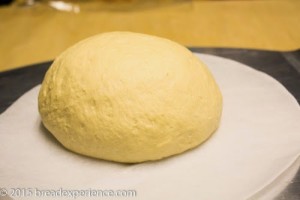 |
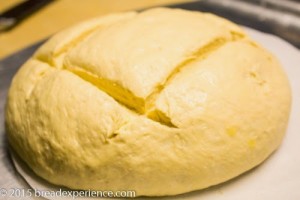 |
Baking the Loaf:
On the Baking Stone: Transfer the loaf (on the parchment paper) directly to the baking stone. Place several ice cubes in the steam pan and immediately close the door.
On the Baking Sheet: Place the baking sheet on the bottom rack in the oven.
Bake the loaf at 450 degrees F. for 20 minutes or until it sounds hollow when thumped on the bottom.
Cool completely before slicing and serving.
This bread doesn’t have an open crumb structure (i.e. big holes) like ciabatti or baguettes which utilize slack (wet) dough and require long fermentation times to develop the gluten, but it is a delicious and flavorful loaf with a hint of spice due to the Einkorn. It can be enjoyed with dinner, as a sandwich, or toast, or plain with butter.
Happy Baking!
Cathy
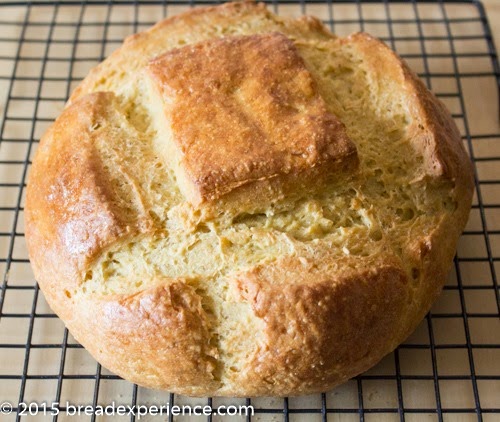
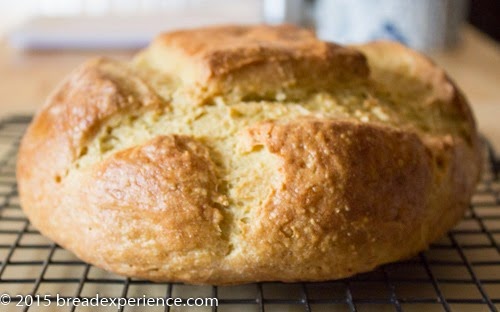
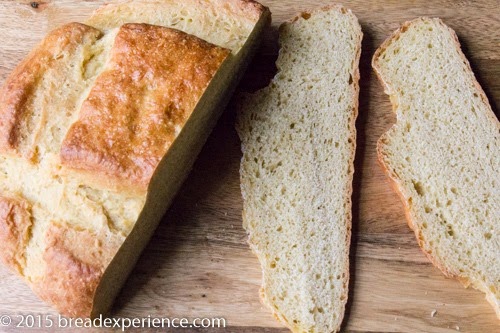
MJ Coons says
Kathy, I have an order for Einkorn flour and I will try this recipes first. I have used the slow rise method with KA flour and we love that method, too.
Will keep you posted. The thought a of a slice of bread that I can digest has me salivating!
Cathy says
Hi MJ, Do let me know how it goes. I love working with Einkorn.
Sarah says
Made this today, I eyeballed the yeast and salt and came out fine, maybe a but heavy on the yeast and light on the salt. I mixed and did first rise in same bowl, and patted the dough ball a bit and that was all. Proofed for 1 hour+, had stainless steel bowl on burner set on low for part of time to gently warm it in cold kitchen. Dough had nice bubble forming, worked it a bit and put on cornmeal coated parchment on cookie sheet covered with stainless bowl with burners on low and over preheating with a casserole pan of hot water on bottom shelf steaming oven, 20 min bake time, bread tastes like a biscuit crossed with french bread, really good with some butter and a sprinkle of salt, thanks for recipe 👍
Cathy says
I’m so glad you enjoyed this bread. A biscuit crossed with French bread … a tasty combination indeed!
Elaine says
Made this a few weeks ago, it was the first thing I made with einkorn and was very pleased with it.
Cathy says
That’s great! I’m so glad your einkorn loaf turned out well.
Jessica says
Can you make this recipe into a loaf for poboys?
Cathy says
Yes, you can shape it into an batard or oblong shape instead of a round boule.